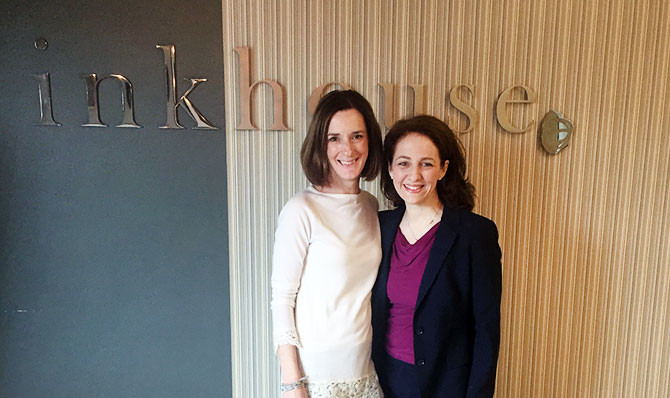Facing Fears and Reducing Stress for a Healthier, Happier Life
Apr 06, 2016 admin
InkHouse Welcomes Guest Lecturer Donna Pincus, Ph D
When most people think about the most stressful jobs in the world, public relations wouldn’t naturally be top of mind, unless you work in the profession. But when you look at the recent CareerCast report on most stressful jobs, Public Relations executive ranks six on the overall list. So, to understand the context, that’s just behind Enlisted Military Personnel, Firefighter, Airline Pilot, Police Officer and Event Coordinator (which is really part PR position). But what this really means is, while we aren’t saving or risking our lives on a daily basis, we are under similar stress factors -- according to CareerCast’s methodology -- including travel, deadlines, working in the public eye, competitiveness, and meeting and interacting with customers and/or the public.
So how can PR pros find ways to cope with their own kind of stress and anxiety in the workplace and be successful in their jobs? We asked InkHouse guest lecturer, Donna Pincus, Ph.D., author of Growing up Brave, and Director of the Child and Adolescent Fear and Anxiety Treatment Program at the Center for Anxiety and Related Disorders at Boston University to recently join us for a lunchtime talk to provide some answers to our questions.
Is Stress a Bad Thing?
Donna explained that being anxious or stressed is actually not a bad thing. Being anxious actually means we are geared up to act and it can actually improve our performance. There is a real physical element to stress and anxiety that puts our bodies in a ready positon (think fight or flight). How we react to that feeling of stress and anxiousness is under our control, and learning to face our fears can be an important key to success in finding a happier and healthier life.
So let’s look at some of the things Donna taught us and how we can overcome the physical and emotional feelings of stress and anxiety. She explained that most of the time fear or worry is what makes us feel anxious or stressed -- fear of failure, fear of public scrutiny, fear of physical injury to ourselves or someone we love, or sometimes fear of the unknown. Worry is another big factor that holds us back from tackling those obstacles in the way of our goals. Worry is a time suck. We spend so much time thinking about unlikely negative outcomes, that we don’t take the time to see the potential for a positive outcome that puts us closer to achieving success.
How Can We Stop Worrying So Much?
Donna encourages anyone stuck in the worry/rumination rut to think like a detective and ask yourself: is there any evidence to support or deny this worry or negative thought? Then once you see you have no evidence to support the worry, find a more realistic interpretation of the thought and ask yourself if you can cope with that. For example, "If I do a bad job on this presentation everyone will laugh at me and I will get fired." There is likely no evidence to support this negative outcome, so you have to let it go and think about the more realistic outcome. You might think instead, “I may feel nervous doing the presentation, but I have done many things successfully before, even when I felt nervous, and it is really unlikely others will laugh at me. Even if they did, it wouldn’t be the very worst thing in the world, I could cope with it.” Getting rid of excessive worry about unlikely outcomes can ultimately help you be more present, focused, and mindful as you face new situations.
These exercises will help you overcome fears while facing them and stop you from practicing avoidance from situations you aren’t comfortable with. Avoidance of fearful situations will actually make the fear grow over time and make it harder to overcome, so always remember it’s better to face your fears than to walk away from an opportunity to overcome them.
How Can We Face Fears and Become Brave?
Bravery doesn’t exist without fear. In order to manage fear and work through it, you need to first create opportunities for yourself to face new situations and experience the fear. You can then develop resilience-building strategies to overcome your scared feelings. Start working on this by creating an environment for yourself to succeed. For example, if you have a fear of speaking in meetings, don’t start off by trying to get through a 45 minute presentation your first time in front of the group. Prepare yourself gradually to face the fear by first presenting one slide, perhaps in a colleague’s presentation, then when you feel victorious from that accomplishment, try more the next time and so on. Before you know it you are facing your fear head on and delivering that 45 minute presentation solo.
Think about creating an environment for yourself to thrive in. Encourage others who you see struggling with anxiety or fears to talk about them and embrace the challenge, rather than avoid it. While we may not be able to control everything that happens in our lives, and our work, we can control how we react to it and how we build our culture to encourage the practice of facing fears. By working through the exercises Donna offered, and teaching ourselves not to fear the worst outcome, we can push forward through those anxious moments. Ultimately, by facing our fears head on, we will feel proud of our accomplishments, healthier and happier, and ready to be brave enough to conquer the next obstacle on our way to success.
Special thanks to Donna for spending her time at InkHouse and for inspiring us all to face those pesky fears! You can find Donna’s book on Amazon and follow her on Twitter.






